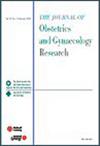Angle of progression as a potential risk factor for emergency cesarean section following induction of labor in Japanese nulliparous women at term
Abstract
Aim
To examine the association between the angle of progression (AOP) measured before labor induction and the occurrence of emergency cesarean section (ECS). Additionally, a predictive model was developed for ECS following labor induction using sonographic and clinical data accessible to obstetricians.
Methods
This prospective observational cohort study was conducted at the Yamanashi Prefectural Central Hospital between January 2022 and July 2024. A total of 143 nulliparous Japanese women with singleton term pregnancies in the cephalic presentation were recruited. Transabdominal and transperineal ultrasound examinations were performed before labor induction. All variables with a p-value of <0.05 in the bivariate analysis were evaluated using multivariable logistic regression analysis to examine the association between AOP and ECS and to identify AOP cutoff values predictive of ECS.
Results
The incidence of ECS was 39.9% (57/143). Multivariable analysis indicated that the AOP (adjusted odds ratio [OR]: 0.89, 95% confidence interval [CI]: 0.85–0.94) and pre-pregnancy body mass index (adjusted OR: 1.14, 95% CI: 1.03–1.27) were associated with ECS. The prediction model had a sensitivity and specificity of 82.5% and 82.6%, respectively (area under the curve [AUC] = 0.88). The optimal AOP cutoff point for predicting ECS was 91.2° (AUC: 0.77).
Conclusion
The ECS prediction model incorporating AOP may facilitate individualized counseling before labor induction. Women with an AOP less than 91.2° are at an elevated risk for ECS.

 求助内容:
求助内容: 应助结果提醒方式:
应助结果提醒方式:


